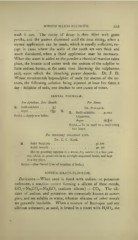Page 555 - My FlipBook
P. 555
SODIUM SILICO-FLUORIDE. 553
wash it out. The cavity of decay is then filled with gutta
percha, and the patient dismissed until the next sitting, when a
second application can be made, which is usually sufficient, ex-
cept in cases where the walls of the tooth are very thick and
much discolored, when a third application may be necessary.
When the water is added to the powder a chemical reaction takes
place, the boracic acid unites with the sodium of the sulphite to
form sodium borate, at the same time liberating the sulphurous
acid, upon which the bleaching power depends. Dr. F. D.
Weisse recommends hyposulphite of soda for abscess of the an-
trum, the following solution being injected at least five times a
day : Sulphite of soda, one drachm to one ounce of water.
DENTAL FORMULAE.
For Aphthous Sore Alotith. For Same.
R. Sodii sulphitis . . . . 3J Dr. Wallace.
Aquae f^j. M.
R. Sodii sulphitis . . . gr.xxx
SiGNA.—Apply as a lotion. Glycerinse,
Aqua; aa^ss.
SiGNA.—To be used on a swab every
two hours.
For Bleaching Discolored Teeth,
Dr. E. C. Kirk.
R. Sodii Sulphitis gr.ioo
Acidi boracis gr. 70
Mix by grinding together in a warm, dry mortar, to a fine pow-
der, which is preserved in an air-tight stoppered bottle, and kept
in a dry place.
SiGNA. — (See Dental Uses of Sulphite of Soda.)
SODIUM SILICO-FLUORIDE.
Derivation.—When sand is fused with sodium or. potassium
carbonate, a reaction occurs forming a silicate of these metals,
SiO.+ NajCOg^NaoSiO, (sodium silicate) + COj. , The sili-
cates of sodium and potassium are commonly known as water-
glass., and are soluble in water, whereas silicates of other metals
are generally insoluble. When a mixture of fluor-spar and any
silicious substance, as sand, is heated in a retort with HgSO^, the


